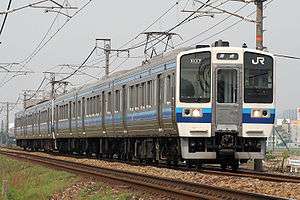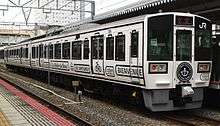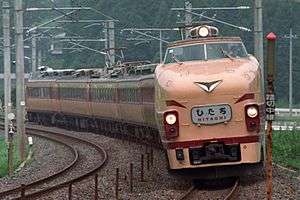213 series
The 213 series (213系, 213-kei) is a suburban electric multiple unit (EMU) train type introduced in March 1987 by Japanese National Railways (JNR), and currently operated by West Japan Railway Company (JR-West) and Central Japan Railway Company (JR Central) in Japan. It is based on the earlier 211 series, although it differs in having two pairs of doors per side on each car instead of three.
| 213 series | |
|---|---|
 JR-West 213-0 series | |
| Manufacturer | Hitachi, Kawasaki Heavy Industries, Kinki Sharyo, Nippon Sharyo, Tokyu Car Corporation |
| Replaced | 119 series |
| Constructed | 1987–1991 |
| Entered service | March 1987 |
| Number built | 65 vehicles |
| Number in service | 26 vehicles (JR West) 28 vehicles (JR Central) (as of 2019) |
| Number scrapped | 7 vehicles, 2 vehicles (U@tech) |
| Operator(s) | JNR (March 22–31, 1987) JR-West (April 1, 1987–Present) JR Central (1989–Present) |
| Specifications | |
| Car body construction | Stainless steel Steel (KuRo 212) |
| Car length | 20,000 mm (65 ft 7 in) |
| Width | 2,950 mm (9 ft 8 in) |
| Doors | 2 pairs per side |
| Maximum speed | 110 km/h (70 mph) 130 km/h (80 mph)(U@tech) |
| Traction system | Resistor control + field system superimposed field excitation control |
| Electric system(s) | 1,500 V DC |
| Current collection method | overhead catenary |
| Bogies | DT50B(powered car),TR235B(trailer car)(213-0 series) WTR235(KuRo 212) WTR235BX(SaYa 213) WTR235XB(KuYa 212) C-DT56(powered car),C-TR241(trailer car)(213-5000 series) |
| Safety system(s) | ATS-SW (213-0 series), ATS-ST (213-5000 series), ATS-P (213-0 series(U@tech)) |
| Multiple working | 313 series 223 series (U@tech) |
| Track gauge | 1,067 mm (3 ft 6 in) |
Operations
From 1988 to 2003, the JR-West sets were mainly used for the Marine Liner service connecting Okayama and Takamatsu via the Great Seto Bridge. These trains sometimes used a panoramic cab car (numbered KuRo 212), the latter was scrapped in 2008.
 KuRo 212 panoramic coach in 1988
KuRo 212 panoramic coach in 1988
Formations
JR-West
3-car sets
| Car No. | 1 | 2 | 3 |
|---|---|---|---|
| Designation | T'c | T | Mc |
| Numbering | KuHa 212-0 | SaHa 213-0 | KuMoHa 213-0 |
| Capacity Total/Seated |
66/58 | 76/64 | 68/60 |
| Designation | T'c | T'c | Mc |
| Numbering | KuHa 212-8 | KuHa 212-7 | KuMoHa 213-10 |
| Capacity Total/Seated |
66/58 | 66/58 | 68/60 |
2-car sets
| Car No. | 1 | 2 |
|---|---|---|
| Designation | T'c | Mc |
| Numbering | KuHa 212-0 | KuMoHa 213-0 |
| Capacity Total/Seated |
66/58 | 68/60 |
| Numbering | KuHa 212-100 | KuMoHa 213-0 |
| Capacity Total/Seated |
114/72 | 68/60 |
U@tech
| Car No. | 1 | 2 | 3 |
|---|---|---|---|
| Designation | T'zc | Tz | Mzc |
| Numbering | KuYa 212-1 | SaYa 213-1 | KuMoYa 223-9001 |
| Capacity | Non-passenger | ||
JR Central
2-car sets
| Car No. | 1 | 2 |
|---|---|---|
| Designation | T'c | Mc |
| Numbering | KuHa 213-5000 | KuMoHa 213-5000 |
| Capacity Total/Seated |
133/50 | 133/54 |
La Malle de Bois tourist train

From spring 2016, a 213 series two-car set was modified to operate on sightseeing services in the Okayama area. The train is modified with bicycle spaces and seat approximately 52 passengers.[1]
The train is formed as follows.[2]
| Car No. | 1 | 2 |
|---|---|---|
| Numbering | KuRo 212-7004 | KuMoRo 213-7004 |
| Capacity | 25 | 26 |
References
- JR全車輌ハンドブック2006 [JR Rolling Stock Handbook 2006] (in Japanese). Japan: Neko Publishing. 2006. ISBN 4-7770-0453-8.
- JR電車編成表 '07冬号 [JR EMU Formations - Winter 2007] (in Japanese). Japan: JRR. December 2006. ISBN 4-88283-046-9.
- JR西日本岡山支社に観光列車 [JR-West Okayama Division to introduce sightseeing train]. Tetsudo Hobidas (in Japanese). Japan: Neko Publishing Ltd. 20 May 2015. Retrieved 20 May 2015.
- 213系「La Malle de Bois」 [213 series "La Malle de Bois"]. Japan Railfan Magazine (in Japanese). Vol. 56 no. 662. Japan: Koyusha Co., Ltd. June 2016. p. 88.
External links
| Wikimedia Commons has media related to 213 series. |
- JR Central 213 series information (in Japanese)

